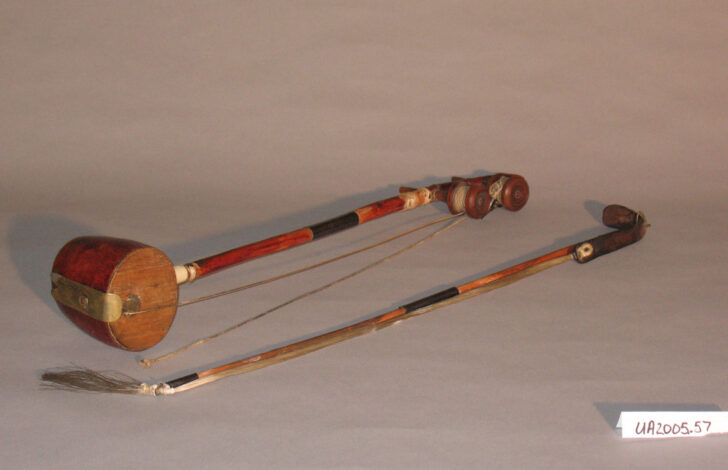Two-stringed Fiddle (Haegum)
Korean

Description
Two-stringed fiddle (haegeum)
Korea
Joseon dynasty (1392–1910)
Late 19th–20th century
Body: sanyuja and bamboo wood with ivory,
silver, and silk thread
Bow: wood with horsehair and silver
Gift of Bruce and Inta Hasenkamp and
Museum purchase made possible by Elder
The haegeum was imported to Korea from China in the thirteenth century during the Goryeo period
(918–1392). It is played by drawing a bow across the instrument’s two body strings, producing a clear
and high-pitched sound. Although the haegum was used widely by street singers and beggars to attract
attention, it was also used in court ceremonies beginning in the late Joseon period (1392–1910). Starting
in the 1930s many musicians began to study the haegeum at Yiwangjik A’akbu, a national school of music for aspiring performers in traditional and modern musical instruments. At Yiwangjik A’akbu, musicians trained to be professional performers and composed the first structured haegeum scores. Today, the haegeum has been adopted in both traditional and contemporary Korean music for its potential to produce a wide range of sounds.
Subject Matter:
A traditional Korean string instrument. It creates soundby the friction between the strings made of silk and the bowstrings made of horsehair.
Physical Description:
An instrument consisting of a hollow sound box, a bamboo beck, two pegs in the upper neck wound with strings, two strings, and a bow. The sound box is made of sanyuja wood.
This is a traditional Korean musical instrument with two strings. Sound is produced by the friction between strings made from several strands of thin silk thread and bowstrings made of horsehair. Its unique sound has earned the haegeum alternative, onomatopoeic names such as gaenggaengi and aenggeum. The instrument consists of a hollow sound box, a bamboo neck, two pegs in the upper neck each wound with a string, the strings themselves, and a separate bow. The pegs are currently detached from the neck. The sound box is made of sanyuja wood (Xylosma congestum).
[Korean Collection, University of Michigan Museum of Art (2017) p. 288]
Usage Rights:
If you are interested in using an image for a publication, please visit https://umma.umich.edu/request-image/ for more information and to fill out the online Image Rights and Reproductions Request Form.